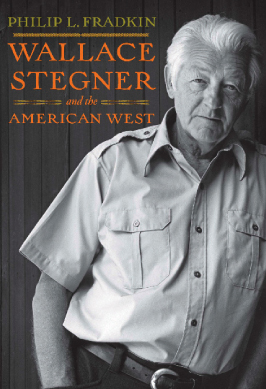Environmental writer PhilipL. Fradkin tells a good story about how he met Wallace Stegner. Fradkin had just published A River No More: The Colorado River and the West, what he calls his “first real book,” when he received a handwritten note from the famous author, who was then teaching at Stanford. The note informed him that Stegner was about to write a review of Fradkin’s “splendid book” for the New Republic. “It was my first real validation as a writer,” says Fradkin from his home in West Marin. “And here’s the master of the subject calling it a splendid book.
Although they met in person only once, the two men sustained an intermittent correspondence until Stegner’s death in a car accident in 1993. It was later, while looking up Stegner’s file in the University of Utah archives, that Fradkin discovered Stegner had once nominated him for a MacArthur “genius” fellowship. “I didn’t receive that grant or any of the others for which he wrote recommendations on my behalf, but that certainly was not his fault,” he writes in the introduction to his new biography Wallace Stegner and the American West.
It is no surprise that after 10 books on the West, Fradkin would take on Stegner as his subject. “He captured the West in the 20th century; he came to symbolize it,” Fradkin says. Although most people know Stegner as a prolific fiction writer and winner of the Pulitzer for his novel Angle of Repose, he should be remembered equally as a teacher and conservationist, Pradkin believes. “He was an incredible teacher of writers; he basically invented the idea that you could teach writing. He also became active in the conservationist movement. He got off his ass and did, and that is something few writers do [or] have done.”
That the book came to be at all is, like many good ideas, a bit of a fluke. Fradkin hadn’t planned on writing a biography, much less one on Stegner. He had just finished his best-selling book The Great Earthquake and Firestorms of 1906: How San Francisco Nearly Destroyed Itself when he got a letter from Page Stegner, Wallace’s son, who was compiling his father’s correspondence into a book and wanted to know if Fradkin had any letters.
Unfortunately, Fradkin’s letters from Stegner had been lost in a house fire, but the conversation sparked an idea. “I called Page back and asked if he would help, if we could help each other.” Page Stegner agreed to the biography, but he didn’t want an academic or a puff-piece approach. Fradkin assured him that neither was his intent. “I wanted to do two things: write the story of a life, and explore how landscape shapes character, something I’ve always written about.”
The result, published just in time for what would have been Stegner’s 99th birthday, is a book about a complex person whose life’s work is woven into the history, culture and future of the West. When asked what he thinks Stegner’s most important legacy is, Fradkin pauses. “People who read the book will come to their own conclusions. The grand total is unclassifiable. I can’t put him in a niche.”
The Local Type
Small Plates, Perfect Wines by Lori Lyn Narlock (Andrews McMeel, $17) Napa food writer Lori Lyn Narlock presents 50 small plate recipes from around the world, including grilled pork with plum sauce, lamb-filled roasted onions, and crab salad with remoulade. Each recipe is paired with a wine. Award-winning Fairfax designer Jennifer Barry designed the book, which abounds with lush images and vivid colors.
Gardening at the Dragon’s Gate by Wendy Johnson (Bantam, $25) For more than 30 years, Wendy Johnson has been meditating and gardening at the Green Gulch Farm Zen Center. Gardening at the Dragon’s Gate is part memoir by a passionate gardener, part master class in organic gardening, part meditation on the natural world. Illustrated throughout with beautiful line drawings by Davis TeSelle, it’s a rich and unique book in the tradition of Thoreau’s Walden.
Special Event
Geography of Hope
A Conference Celebrating Wallace Stegner
March 7–9, 2008
Point Reyes Station
We simply need that wild country available to us, even if we never do more than drive to its edge and look in. For it can be a means of reassuring ourselves of our sanity as creatures,
a part of the geography of hope.
—from The Sound of Mountain Water
by Wallace Stegner
When Philip L. Fradkin told his friend Steve Costa, owner of Point Reyes Books, about the publication of his new book on Stegner, Costa asked what he could do to help get the word out. What could have been another wine-and-cheese book reading morphed into an entire weekend celebrating Stegner’s life and legacy as a chronicler, lover and protector of the West. The “Geography of Hope” conference was born.
Literary luminaries such as Robert Hass, James D. Houston, William Kittredge and other writers, agents and thinkers will be on hand for lively talks, discussions, and readings. In addition to literary events, MALT, the Point Reyes National Seashore and other local movers and shakers will be leading field trips to explore the beautiful natural and agricultural riches of West Marin. Visit Straus Family Creamery, Tomales Bay Oyster Company, Black Mountain, Chimney Rock and other spectacular sites to discover why there is hope for Marin’s wildlands, wetlands, farms and ranches.
For a complete schedule of events and to buy tickets, contact Point Reyes Books at ptreyesbooks.com or 415.663.1542.
Proceeds from the conference will help fund the West Marin Writer-in-the-Schools Program.


